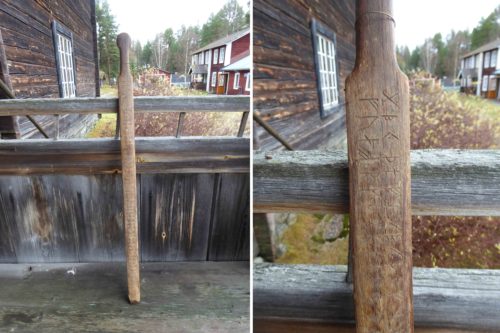
The Haverö runes – the key to the mystery of the Kensington Stone?
I never thought that I would ever devote any time to the Kensington stone from America, but sometimes fate takes a different turn. Many have dedicated their lives to proving that it is a genuine runic inscription carved by Scandinavians in 1362 in what would become one of the Swedish districts of Minnesota in the nineteenth century. Experts, on the other hand, have mostly dismissed it as a fake, and in fact one does not need to be very well versed in runology to realize that this cannot possibly be a runic inscription from the fourteenth century. Yet the inscription contains a number of interesting and as yet unsolved riddles: who carved the stone, what is the meaning of the text and not least – where does the peculiar runic alphabet come from?
This article was first published in Swedish on november 26, 2017
In March 2017 I was going through a box at Runverket containing a variety of material about the runes of Dalarna and happened to see a photostat copy of a newspaper article entitled “The Haverö runes”. The article was signed Carl Viksten, but otherwise there was no information about where and when it was published. It was about a stick with strange-looking runes that had been noticed “a few years ago” in the local heritage museum at Haverö in Medelpad. According to the article, “the leading expert on runes in Sweden”, Professor Otto von Friesen, had been consulted about the runes in 1942, but he had said that he did not know of anything comparable, although he thought they partially resembled the runes of Dalarna. The statement was a bit strange, because it is clear from the drawing in the newspaper article that it is an alphabet with the same type of runes as on the Kensington stone!
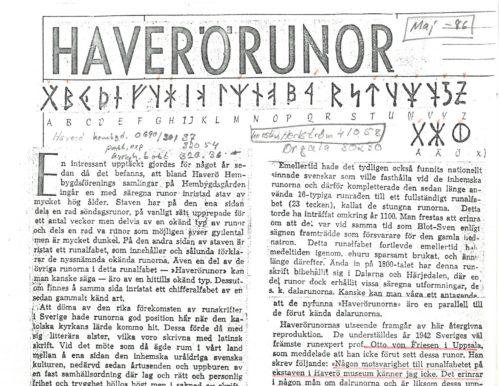
How could this inscription be completely unknown? And was the runic stave still there? I found my way to the Haverö Local History Association online and saw a phone number, which I dialled. Yes, it was still there, I was told, but at that time there was too much snow to be able to get up to the museum. However, the matter would be investigated as soon as possible and I was also promised pictures of the object. When these came by email early this summer, I could see that it was indeed a complete alphabet that almost exactly corresponded to the runes on the Kensington stone, but the stick also had other types of runes and characters. Some of these were rather difficult to identify in the photographs. Other work called for my attention, however, and the whole thing had to wait.
At the end of September, I saw a new article in Saga och Sed 2016 by Staffan Fridell and Mats G. Larsson, who had identified the dialect on the Kensington stone. The language there is highly peculiar and has been interpreted as a mixture of Swedish, Norwegian and English. The result pointed to Härjedalen and the area around Nedersiljan in Dalarna, suggesting that the author may have been Anders Andersson, a person in the immediate circle around the finder of the stone, Olof Ohman. Andersson was born in Djursvallen in the parish of Linsell in Härjedalen. Fridell and Larsson envisage that Andersson may have learned about the somewhat unusual rune system on a trip to Dalarna, where some examples of these particular runes have recently been found.
I immediately realized that the examination of the runes on the Haverö stave could not wait any longer and that I had to get there before the snow made the object inaccessible for another six months. I contacted Margareta Wiklund, who had helped me locate the stave, to see if it was possible to look at it in the near future. She said it was, and at the end of October I undertook a semi-improvised research trip to Medelpad and Jämtland, which also gave some other results.
For a long time, there were no known equivalents to the runes on the Kensington stone, but when the stone was exhibited at the Swedish History Museum in 2003, they began to appear. The first object to attract attention was the yoke from Månsta in Älvdalen, dated to 1907, and then came records of a complete runic alphabet, one from 1883 and one from 1885, by the two Larsson brothers from Dala-Floda in Dalarna, known as the Larsson runes. A few years ago, a couple of postcards from 1906 and 1909 with Kensington runes appeared along with a sheet of paper bearing another alphabet at the home of Gerda Werf in Loka in Älvdalen. Only the Larsson runes are older than 1898 – the year the Kensington stone was discovered – but several of the runes here have a different form from those on the stone.
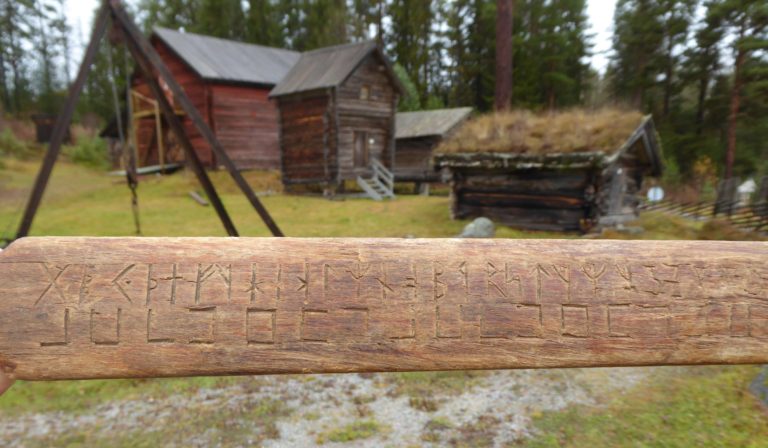
When I had the opportunity to study Haverö runes on the original object, I noticed that these, unlike the Larsson runes, were almost identical to the runes of the Kensington stone. The characters that are missing on the Kensington stone, such as c, y, x, z and å, on the other hand, have almost exactly the same shape as the corresponding characters among the Larsson runes. The Haverö runes thus seem to be the missing link between the Larsson runes and the Kensington stone. I did not know at the time that the runic alphabet in Gerda Werf’s possession is identical, apart from a couple of details, to the character set on the Haverö stave. These two sources are therefore at the same stage of development and must surely be related.
However, this is not the only similarity between the newly discovered sources. On the Haverö stave, the Kensington runes are followed by what at first glance almost looks like GOD JUL (Merry Christmas) written in angular letters, but it is actually an alphabet in the angle cipher (also called the Masonic cipher). The same type of cipher is also recorded in the papers left by the Larsson brothers and the items in the possession of Gerda Werf.
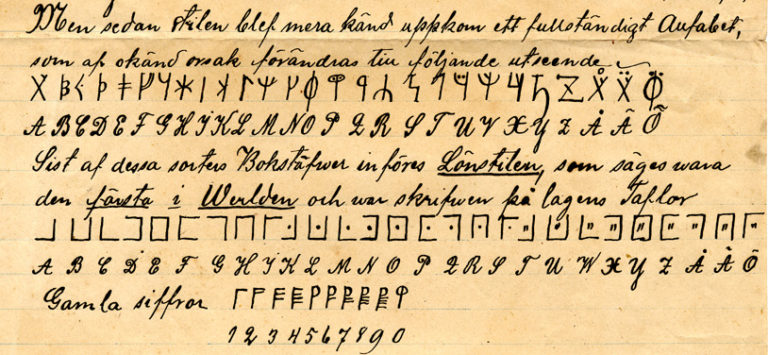
When I immersed myself in the literature about this cipher, I learned that during the nineteenth century it was especially common in the area around Rätan in Jämtland, but that it was also used in the summer pastures in the western part of the province. The artist and folklife researcher Nils Månsson Mandelgren, who visited the area north of Åre in 1869, witnessed a young man carving signs like these on a piece of wood to leave a message for his betrothed. Mandelgren therefore suggested that these characters, which were previously unknown to him, should be called “love runes or Jämtland runes”. A variant of the same cipher also occurred in Møre, Norway, during the nineteenth century. According to an article in Norsk Landboeblad in 1811, it was called “the Mørsk alphabet” and was used in the area for at least half a century. Likewise, the Icelanders who collected different types of runic alphabets in the nineteenth century recorded this cipher, but they called it grindaletur or “lattice letters”.
It is undeniably striking that the angle cipher and the Kensington runes are recorded together in the three alphabets that we now know. I think this gives us a hint as to how these runes were originally used. It was probably a secret written language that was created and handed down by a certain group of people. It has previously been suggested that it was used by itinerant craftsmen, but it could also be something that was learned in childhood and was perhaps mainly used among children. The runologist Jan Ragnar Hagland has cited several examples of the latter from nineteenth-century Norway.
Many people have wondered where the peculiar runes on the Kensington stone come from. An old suggestion is that they are based on the runes found in a book by Carl Rosander, Den kunskapsrike skolmästaren (The Knowledgeable Schoolmaster), which we know that Olof Ohman, the finder of the stone, had a copy of. However, the runes depicted there have very little in common with the Kensington runes. Others have suggested that it is a variant or branch of the Dalarna runes, the runic alphabet used in Mora and Älvdalen from the sixteenth century and to some extent until the start of the twentieth century. This ignores the fact that almost all the typical Dalarna rune forms are missing from the Kensington runes and that the very distinctive g-rune, which is the Dalarna rune that survived longest, is not at all like the g on the Kensington stone. However, there is much in common with the folk runes used in Norway in recent times. For these it is easy to point to a clear source: the runic alphabet of Johannes and Olaus Magnus, which was printed in Rome in 1554 and 1555 and which was then reproduced in many other later writings.
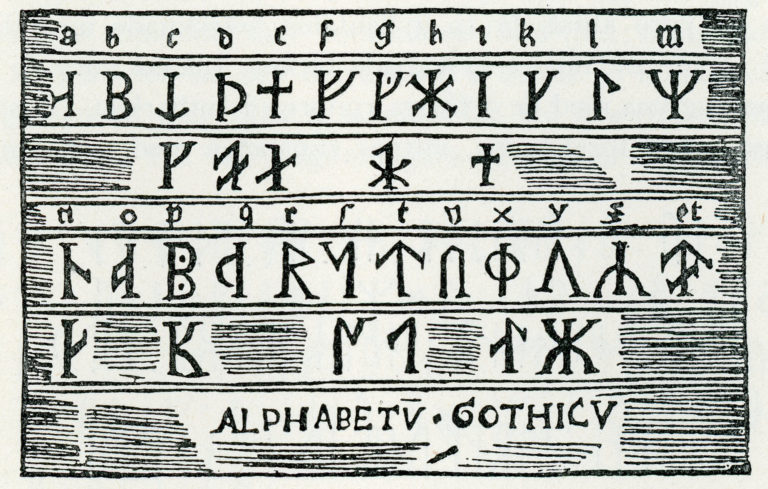
The simplest explanation is that the creator of the Kensington runes proceeded from a “Norwegian” post-Reformation runic alphabet of this kind, but changed some of the rune forms to make it less transparent for the uninitiated. Perhaps this happened in Jämtland, which has close ties to Norway. The fact that the Kensington runes are linked to the angle cipher, which seems to have been particularly popular in Jämtland in the latter part of the nineteenth century, points in the same direction. Haverö in Medelpad also borders on Jämtland, and from there it is not very far to Linsell in Härjedalen, where Anders Andersson lived before moving to America!
There are more runes on the Haverö stave than those I have mentioned so far, and these can provide another small – but at the same time somewhat puzzling – clue. In two rows, the carver has repeated the sequence of characters abcdefg several times, in the angle cipher and in the Kensington runes. This suggests that he was inspired by the seven Sunday letters from some calendar stave. These are followed by a long series of runes similar to the golden numbers, which also go back to the calendar staves. There should be 19 of these, but here there are 21, because a couple of the runes appear in two different variants. In addition, the third rune is a instead of the expected þ, and the order of the last four characters – ʀ, árlaug, tvímaðr and belgþorn – is reversed. After this come the three dotted runes y, g and e and a non-dotted b-rune. Then come another 29 runes with more or less strange shapes. Since each character is unique, it seems reasonable that this is yet another (previously unknown?) runic alphabet.
When I held a seminar in Uppsala about the Haverö stave last Thursday evening, I was convinced that the first 21 characters were taken from a rune calendar and that the rune carver had then added the dotted variants of some of the characters. My thought was that this revealed his ignorance of the calendar runes, which was an indication that the runes are relatively late. When I woke up on Friday morning, I suddenly realized what it was all about. This rune sequence does not reproduce calendar runes, but corresponds almost exactly to the order of the runes shown on one and the same page in Den kunskapsrike skolmästaren, the book that we know was owned by the finder of the Kensington, Olof Ohman! What I thought was the golden number rune belgþorn is based instead on a variant of the m-rune, which is shown there in two forms. The only thing that has happened is that the carver has accidentally skipped the þ-rune and then forgotten a lateral stroke in the following o-rune which is also shown in two different shapes. After the sequence of runes he added the two golden number runes tvímaðr and árlaug, which were apparently understood as bind runes, and then tried to render the four dotted runes, y, g, e, p, which are shown further down on the same page of the printed book.
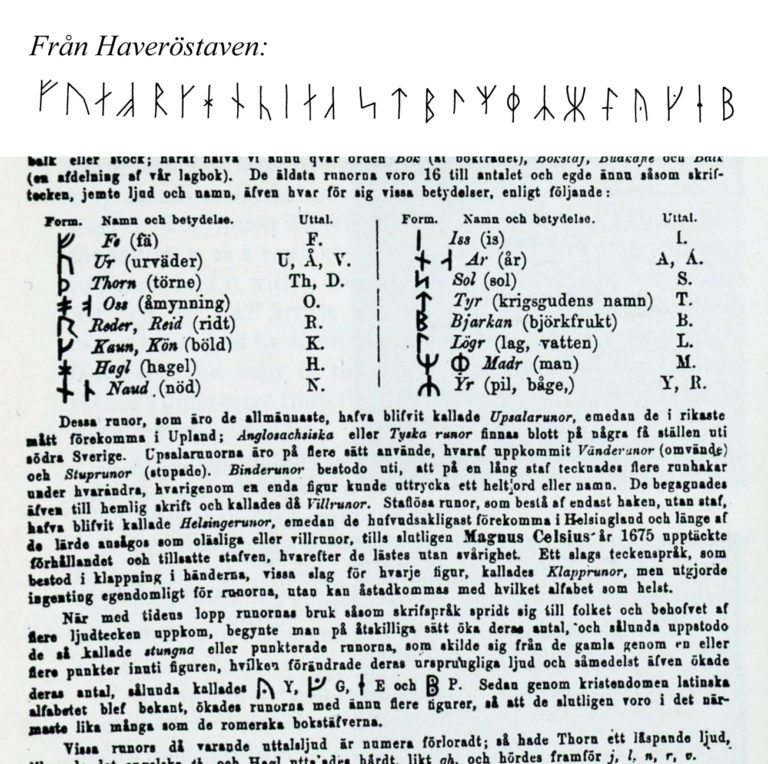
The person who carved the runes on the Haverö stave was familiar with both the Kensington runes and the angle cipher, but also had access to information about runes from a printed book, which we know the finder of the Kensington stone actually owned. This, together with Fridell’s and Larsson’s study, which places the dialectal features of the language of Kensington stone in Härjedalen, means that the previous suspicions against Anders Andersson from Linsell are significantly strengthened. Of course, this is not a definitive solution to the Kensington problem, but I am convinced that we are on the track of the origin of the Kensington runes, and that we should be searching slightly further north than hitherto considered.
Magnus Källström is a runologist, associate professor and researcher in the field of runic studies at the Swedish National Heritage Board
- Jan Ragnar Hagland’s article on the modern use of runes in Norway (“Etterreformatoriske runer og kvardagsleg skriftpraksis på 1800-talet”) can be read in this publication.
Other articles in English:
Kensington runes in Hälsingland
How the runes went from Hassela to Minnesota